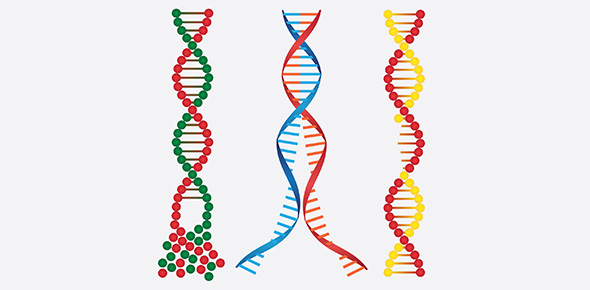Related Flashcards
Related Topics
Cards In This Set
| Front | Back |
|
What is the difference between a nucleotide and a nucleic acid? 2 marks
|
A nucleotide is the monomer (1); a nucleic acid is the polymer (1)
|
|
Similarities and differences between DNA and RNA: 6 marks
|
- DNA is double-stranded; RNA is single-stranded (1)
- DNA contains thymine; RNA contains uracil (1)
- DNA contains the sugar deoxyribose; RNA contains ribose (1)
- Both contain guanine, cytosine and adenine (1)
- Both contain a 5-carbon sugar (1)
- Both contain a phosphate group (1)
|
|
Key events of transcription: 6 marks
|
|
|
Key events of translation: 6 marks
|
|
|
Important features of the genetic code:
|
It is non-overlapping (specific start an stop codons) (1); it is degenerate (some amino acids are coded for by more than one codon) (1)
|
|
Replication of DNA: 4 marks
|
- double helix unzips
- hydrogen bonds break
- free DNA nucleotides complementary base pair with exposed bases on both strands
- DNA polymerase joins nucleotides together on the new strands (catalyses formation of ester bonds)
|
|
What does semi-conservative replication mean? 2 marks
|
Two new molecules are formed which are exact copies of the original (1); one of the chains in each new molecule was present in the original molecule (1)
|
|
How does DNA control the phenotype of an organism? 3 marks
|
DNA controls the production of enzymes (1); enzymes control metabolic pathways (1); metabolic pathways influence the phenotype of an organism (1)
|
|
Stages of mitosis (PASS ME A TENNER!)
|
|
|
Preparing a mitotic squash: 3 marks
|
Cut end tip off growing root (1); add aceto-orcein stain (1); squash (1)
|
|
Why do you follow these steps? 3 marks
|
Root tip end has fast growing cells (1); stain to make chromosomes visible (1); squash to get a thin tissue layer letting enough light through for the optical microscope (1)
|
|
Stages of the cell cycle:
|
G1 (cells prepare for DNA replication); S (DNA replication); G2 (short gap before mitosis); M (mitosis)
|
|
Similarities and differences between mitosis and meiosis:
|
- meiosis produces gametes; mitosis produces other body cells
- meiosis produces cells with 23 chromosomes (haploid - n); mitosis produces cells with 46 chromosomes (diploid - 2n)
- meiosis produces cells that are genetically different; mitosis produces cells that are genetically identical
- both go through prophase, metaphase, anaphase and telophase
|
|
Chromosome movement during meiosis:
|
- in first division, homologous chromosomes pair up
- equivalent portions of chromatids may cross over
- homologous pairs separate during meiosis 1, with one chromosome from each pair going into the two daughter cells
- this happens randomly and is called independent segregation
- chromatids move apart during anaphase of the second meiotic division
- after the second division, four haploid daughter cells are formed
|
|
How does meiosis produce genetic variation? (4)
|
Recombination of sister chromatids after crossing over during prophase of meiosis 1 (1) produces new combinations of alleles (1). Independent segregation of homologous chromosomes during anaphase of meiosis 1 (1) produces gametes with randomly assorted chromosome combinations (1).
|






